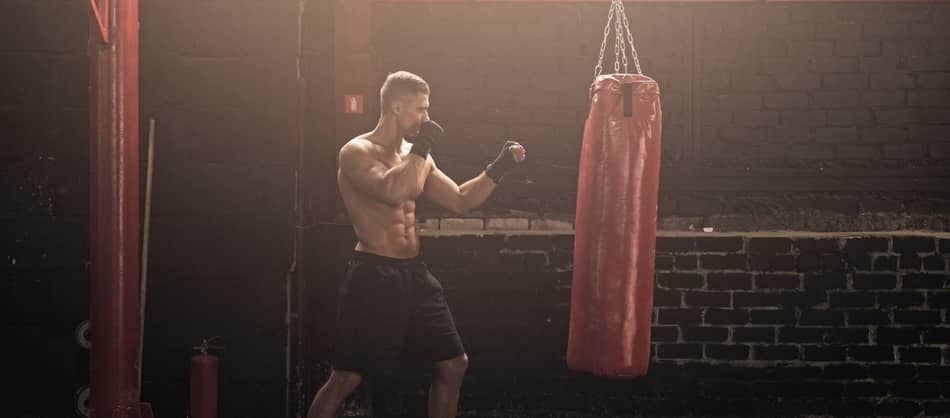
Choosing a punching bag can be daunting. There are so many different styles, sizes, weights, and varying qualities, and each type of bag has its own specific purpose to help you meet your goals. Just thinking about all of the options can give you a headache! Here in a nutshell is the information I have gathered to help you determine which punching bag is right for you.
Choose a heavy bag that’s about half your weight to develop overall punching & kicking technique, a free-standing or wall mounted bag when a ceiling mount isn’t an option, a speed bag to increase punch speed and timing, a double-end bag to hone reflexes and improve counter punches, and an uppercut bag to sharpen all punches especially uppercuts.
Unless you own a gym, you aren’t going to need each of these different types of punching bags. One bag will usually suffice, but there are a couple of bags that you might want to own in addition to your main punching bag to up your boxing or kickboxing game.
Aside from gloves, a punching bag is the most necessary and useful piece of equipment for a boxer, kickboxer, or Mixed Martial Artist, so it’s crucial to get it right. Here we’ll take an in depth look at the different types of punching bags, what they are used for, average costs, and what to look for in a bag so that you will be able to make the best decision possible, and save yourself from wasting any money.
The following is a quick and easy reference chart for choosing a punching bag.
| Description: | Best For: | Average Cost: | |
| Hanging Heavy Bag | cylindrical 40-200 pounds | general boxing, kickboxing, MMA | $100-$400 |
| Freestanding Punching Bag | cylindrical- secured to weighted stand | general boxing, kickboxing, MMA | $150-$300 |
| Muay Thai Heavy Bag (Banana Bag) | cylindrical, narrow, at least 6′ in length | Muay Thai & kickboxing- general kicks and punches | $100-$400 |
| Speed Bag | small light weight tear drop or sphere shaped | boxing, punching speed & timing | $30-$50 |
| Tear Drop Bag | 4′ long, 40-80 lb, tear drop shape | boxing, kickboxing, MMA- speed, timing, accuracy | $100-$200 |
| Wall Bag | rectangular pad, some include padded ledge that juts out at the top, secures to wall | those with limited space- punching skills | $150-$300 |
| Double End Bag | spherical or hour glass shape secured from top and bottom by elastic band | boxing footwork, slips, rhythm, timing | $30-$80 |
| Angle Heavy Bag | Wider at top, angles in and narrows toward the bottom | boxing- uppercut training | $150-$350 |
| Grappling Dummy | 30-160 lbs., 4′-6′ tall, | wrestling & MMA- takedowns, throws | $150-$250 |
Now let’s take deeper a look at each type of punching bag so that you can determine which style of bag you will need.
Hanging Heavy Bag
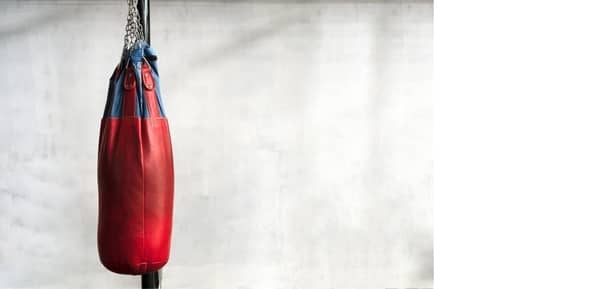
A Hanging Heavy Bag is a cylindrical bag that can weigh between 40 and 200 pounds and averages 4-5 feet in length.
Because heavy bags are generally quite substantial in weight (as the name implies), they will need to be secured from a joist in the ceiling by a chain or very thick rope. These bags are best for overall training, working on punching and kicking techniques, and increasing strength and power.
Hanging heavy bags can be used for kickboxing and MMA, but because they are often shorter in length and aren’t long enough for practicing low kicks, they are better suited for boxing. The Muay Thai or Banana Bag, which is longer than the typical heavy bag, is generally a better option for kickboxing.
If your goal is to increase your power and muscle strength then your heavy bag should provide plenty of resistance, and therefore should be about half your weight. You should round down to the nearest 5 pounds if you are between bag weights. For example, if you weigh 165 pounds half your weight would be 82.5 pounds. Most punching bags come in increments of 5 so you would round down to an 80 pound bag. Hanging heavy bags cost between $100-$400.
Check out this article with a punching bag weight chart to help you determine the exact heavy bag size you’ll need.
Freestanding Punching Bag
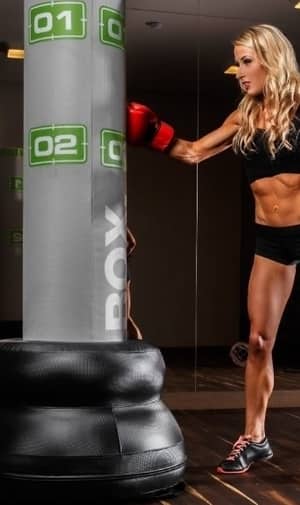
Like the hanging heavy bag, the free standing punching bag is also used for overall training. Many free standing punching bags can also be used for practicing low kicks because the padded portion of the bag is lower to the ground. These bags are a great alternative to a hanging heavy bag if you are unable to hang your bag from the ceiling or you need something a bit more portable.
Free standing bags are also cylindrical in shape and can be between 4-7 feet. Many free standing bags are adjustable in height as well.
The actual bag of a free standing punching bag does not typically come in varying weights like a heavy bag. Many times their listing description will mention a weight, but this usually refers to the overall weight of the entire bag system including the base. Although they do generally include a base that can be filled with water or sand, the weight of the base does not impact the amount of resistance the bag will render.
This is because these bags are most often constructed with a spring loaded core to allow the bag flexibility when you strike it. So if you notice a weight associated with a standing bag, bear in mind that this is most likely just the weight of the filled base or the weight of the bag and stand combined.
Some free standing bags have the added benefit of a removable foam collar. This collar can be left on or removed in order to increase or decrease the movement of the springs and the overall resistance. The flexibility of this type of bag is great, especially if different sized people are sharing it.
This Ringside Elite Freestanding bag is a really nice, well priced adjustable spring bag. Another freestanding bag that is also very reasonably priced and has the added benefit of a suction cup base that keeps the bag from sliding all over the floor when you’re training is this Dripex Freestanding Punching Bag. This bag also includes removable springs to increase the resistance.
There are several advantages to a free standing bag. The adjustable height and resistance is extremely beneficial in many ways. These adjustments can be made when sharing a bag and one might need it to be taller, shorter, or more or less springy. It can also be adjusted during or between trainings in order to change focus from speed to power and vice versa. A more springy bag will allow you to work on speed and a more resistant bag will improve power and strength. So if you want to buy only one punching bag that will encompass many different workouts, a free standing punching bag is a great option.
The drawback to a freestanding bag is that it lacks the weight that a heavy bag can provide. Yes, a freestanding bag’s resistance can be adjusted, but most of these bags will not be able to give you the feel of a 150 pound bag. Serious boxers that are training to compete will usually want a hanging heavy bag to get the most resistance possible. The only other negative to a freestanding bag is their tendency to slide around easily. This can be remedied by filling the base with sand to max out the base weight, or by purchasing a bag with a suction cup base like the one I linked to above.
A quality freestanding punching bag will generally cost $150-$300. You can get them for as little as $30 but these bags are usually extremely light weight and better suited for children. You can also spend far beyond $300, but this isn’t necessary unless you are a professional or own a gym where the bag will be used constantly by many different people.
Muay Thai Heavy Bag (Banana Bag)

Muay Thai heavy bags are slimmer and longer than a traditional heavy bag. They will almost always be at least 6 feet long. They hang from the ceiling and nearly touch the ground when hung properly.
These bags are specifically designed for Muay Thai to practice low kicks and knee strikes but are also a great option for kickboxers and mixed martial artists. Because of their length, Muay Thai bags can also be much heavier than other bags. This will help with training strength and power.
Lighter 50-60 pound Muay Thai bags can run you as little as $60-$100. Heavier bags will be $150-$400 depending on the quality. If you are into Muay Thai, MMA or kickboxing, and you have the space and ability to hang a heavy bag, a Muay Thai style bag would be my pick.
Speed Bag
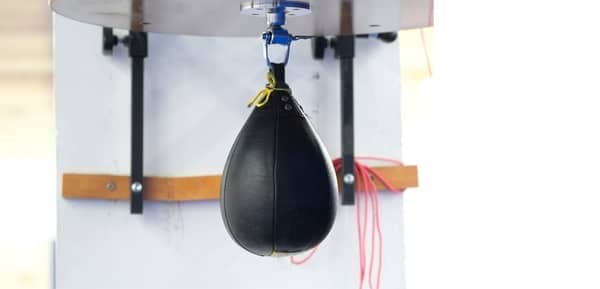
Speed bags are much smaller tear drop or sphere shaped bags filled with air that are typically mounted from the ceiling or the wall.
This type of bag is most commonly used by boxers to improve punching speed, develop endurance, timing and hand eye coordination.
If you want to fine tune your punching skills, the speed bag’s compact size and low price point make it an easy and affordable way to supplement your heavy bag. You can buy a good quality speed bag for $30-$50.
Tear Drop Bag
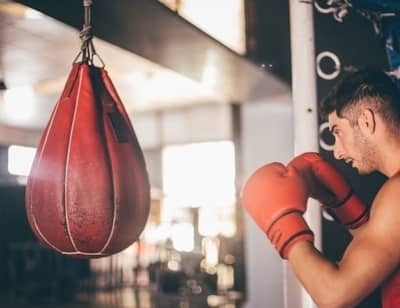
The Tear Drop bag is a variation of a hanging heavy bag. They are typically about 4 feet long and weigh anywhere from 40-80 pounds.
Because of their lighter weight these bags swing more, helping to develop speed, timing, and accuracy. The tear drop shape also reinforces more targeted punches and kicks.
These bags are generally used in more advanced training. They can be used for boxing, kickboxing, or MMA. Tear Drop Bags can cost roughly $100-$200.
Wall Bags and Uppercut Bags
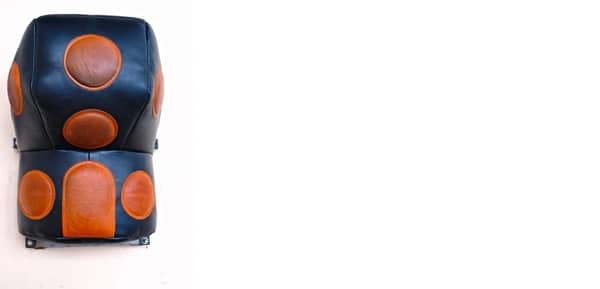
A Wall Mounted Bag, just as the name implies, is a punching bag attached to a wall. These are ideal for someone with a very limited amount of space.
Many wall mounted bags are rectangular in shape with a highly padded ledge that juts out at the top of the bag. These are designed for practicing uppercuts, but can also be used for jabs, hooks, and knee and elbow strikes .
Because of the way they are mounted, wall bags have no give to them so you’ll want to use them with caution. They are great if you’re short on space and don’t have any other options, but not the best pick for overall training. These bags would typically be best suited for very serious or professional boxers.
Wall bags generally run from $150-$300. If you’re a trained boxer looking for a second punching bag to supplement your heavy bag, and/or you’re tight on space, this bag could be exactly what you need.
Angle Heavy Bag
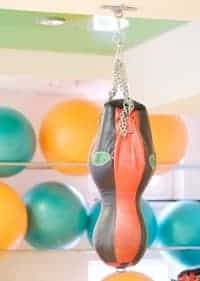
Angle Heavy bags are also secured from the ceiling. They are normally wider at the top, then angle in and narrow at the base of the bag. This allows for more uppercut training, but is also a good bag for practicing all punches and most kicks and strikes.
Angle bags go for $150-$350, but $200 is a good average. This is a bag that is a little more geared to more specific training and is mostly used by more advanced fighters.
Double End Bag
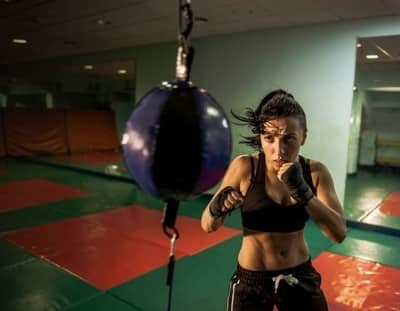
A double end bag is typically a smaller spherical bag that is anchored to both the ceiling and the floor by an elasticized band or bungee cord. This elastic band allows the bag to move freely when struck.
The bounce back from this type of bag provides more opportunity for practicing rhythm, timing, accuracy, footwork, and slips (moving head side to side to “slip” the opponent’s punch). Some of the larger double end bags are designed with more of an hourglass shape to better resemble a person’s body.
These bags are most often used by more experienced boxers, kickboxers, and MMA fighters looking to refine their skills. If you’re trying to decide between a double end bag and a speed bag, keep in mind that a speed bag will help improve punching speed while a double end bag will help with footwork , timing, and accuracy. Think about what your end goal is before making your selection between these two bags. Double end bags cost between $30 to $80.
This interactive double end bag comes with a freestanding frame and base. It has a wireless sensor that syncs with an app that provides thousands of adaptive hiit workouts and gives feedback for improve striking technique. This is a higher end, more expensive version of a double end bag, but well worth the price.
Grappling Dummy
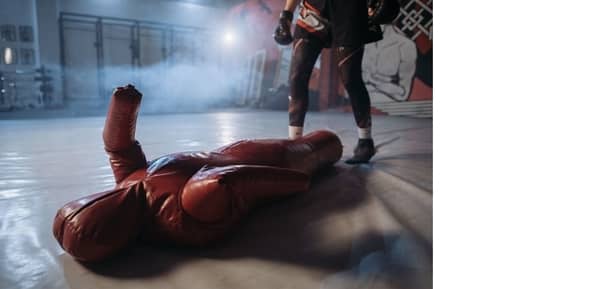
A grappling dummy is a punching bag in the form of a human body. Grappling dummies are most often not attached to a base, the ceiling, or the wall.
The purpose of a grappling dummy is to develop and practice throws, strikes, and takedowns. For this reason, grappling dummies are most often used by wrestlers and MMA fighters.
The cost of a grappling dummy is commonly in direct relation to the weight. You can get a 70 pound dummy for around $150, but for a more realistic 140 pound dummy expect to pay upwards of $250. Keep in mind that the $20-$30 grappling dummies you will find online will almost always come unfilled, and will need to be stuffed with the material of your choice when you receive it.
How to Choose the Weight of Your Punching Bag
As discussed earlier, hanging heavy bags come in weights from 40-200 pounds. If your goal is to increase your muscle strength power then your heavy bag should provide a lot of resistance, and therefore should be about half your weight.
If you’re between bag weights, you should round down to the nearest 5 pounds. For example, if you weigh 185 pounds, half your weight would be 92.5 pounds. Most punching bags come in increments of 5 so you would round down to a 90 pound bag. If you want to focus more on speed and accuracy rather than strength and power, a 40-60 pound bag is usually your best bet. Bags over 100 pounds are typically only used by professional fighters.
This article has a quick and easy reference chart to determine the best punching bag weight for you.
What Type Of Outer Material To Look For
The shell of most punching bags is usually made from leather, or a synthetic material such as PU leather or vinyl. Each of these materials have their pros and cons.
Leather is considered superior because it is the most durable and long lasting, and is often used in hand made punching bags. The drawbacks to leather are that it needs to be maintained, cleaned, and conditioned often, and that it is usually more expensive than other materials.
Synthetic materials are cheaper, easier to maintain, and less susceptible to moisture and mildew. Manufacturers have been able to advance synthetic leather to a point that it is now often difficult to tell them apart from the real thing.
Types of Punching Bag Inner Material
Most heavy bags, free standing bags, and Muay Thai punching bags are filled with a combination of foam, recycled fabric, and bags of sand to get the perfect feel and weight for the bag.
Hard fill bags are filled with shredded fabric and bags of sand inside of a one inch foam liner. These bags are pretty solid and hard on the hands and joints, but also provide a lot of resistance for an excellent workout. Soft fill bags like hard fill bags are also filled with fabric and sand but these have a two inch foam liner.
If you are a beginner, you will definitely want to start with a soft fill bag that will give you that extra cushion. It will still give you a great workout, it will just be a little less taxing on your body.
Some of the other types of punching bags are filled with water. Some people prefer water filled bags because they can better resemble the feeling of punching a human body.
Since speed bags and double end bags are lighter they are most often filled with air. These bags need to be inflated often to keep them at the correct pressure.
Pros and Cons of Filled and Unfilled Punching Bags
Some bags come unfilled and require you to DIY the filling. These punching bags are much less expensive than the filled bags, but they can also be a bit frustrating and difficult to fill correctly. They can end up lopsided, lumpy, and weighted wrong. A quality pre-filled punching bag will be uniformly filled with the weight evenly distributed throughout. But some prefer to fill their own bag so that they can adapt it to best fit their needs.
Filled punching bag
Pros:
- Convenient
- Easy
- Uniform Shape
Cons:
- More expensive
- Usually can’t be modified
Unfilled punching bag
Pros:
- Less expensive
- Can be modified and adapted
Cons:
- Difficult to fill correctly
- Can end up lopsided or lumpy
Which Type of Punching Bag Do Professionals Use
Professional boxing gyms will always have hanging heavy bags of different weights for their pros to use. They will also often have some of the other types of bags listed in this article such as speed bags, double end bags, and uppercut bags to improve individual boxing skills. Muay Thai and kickboxing gyms will generally have the longer heavy Muay Thai bags.
Best Punching Bag For Beginners
Beginner boxers, kickboxers, and mixed martial artists should use a soft filled hanging heavy bag, free standing bag or Muay Thai bag to start with. The bag should have a good amount of give and be a little lighter than half their weight when in the beginning stages. I have an ideal beginner bag that is adjustable in height and resistance. You can check it out in my recommended products page here. As you gain experience, strength, and skill it’s a great idea to increase the weight of your bag, and possibly add a skill specific bag or two to your home gym.
Best Punching Bag Stand
If a hanging bag is what you have your heart set on, but you don’t have the proper set up to hang it, you can get a stand to secure it from. You can also make your own stand. Just google “how to make your own punching bag stand” and you will find all kinds of ways to do this.
For the easier route, just buy a stand online. Here’s a solid heavy duty stand that will hold a hanging bag of up to 100 pounds. This bag is stand is great when you don’t have a good place to safely hang your bag. It can also be moved around, which is very convenient.
How to Decide Which Punching Bag You Need
To determine the punching bag that is going to best meet your needs, check the reference chart above. If you are doing most of your training at home you will need either a heavy bag, free standing bag, or a Muay Thai bag. If you want to work on muscle strength, get a hanging heavy bag or Muay Thai bag that’s half your weight. If possible, choose a Muay Thai bag for kickboxing and MMA. If you don’t have space for a hanging bag get a free standing bag.
It is ideal to have a bag for working on overall punching and kicking skills as well as a bag to refine specific techniques like a speed bag or a double end bag. If you are doing most of your training at the gym, you could get away with only a speed bag, double end bag, or wall mount bag.
Decide what your goals are for the next six months and then get a punching bag that will help you meet those goals. Once those six months are up, reevaluate and decide if you need to switch it up or add something new to meet your next set of goals. Always strive to learn something new or to improve on something you already know!
